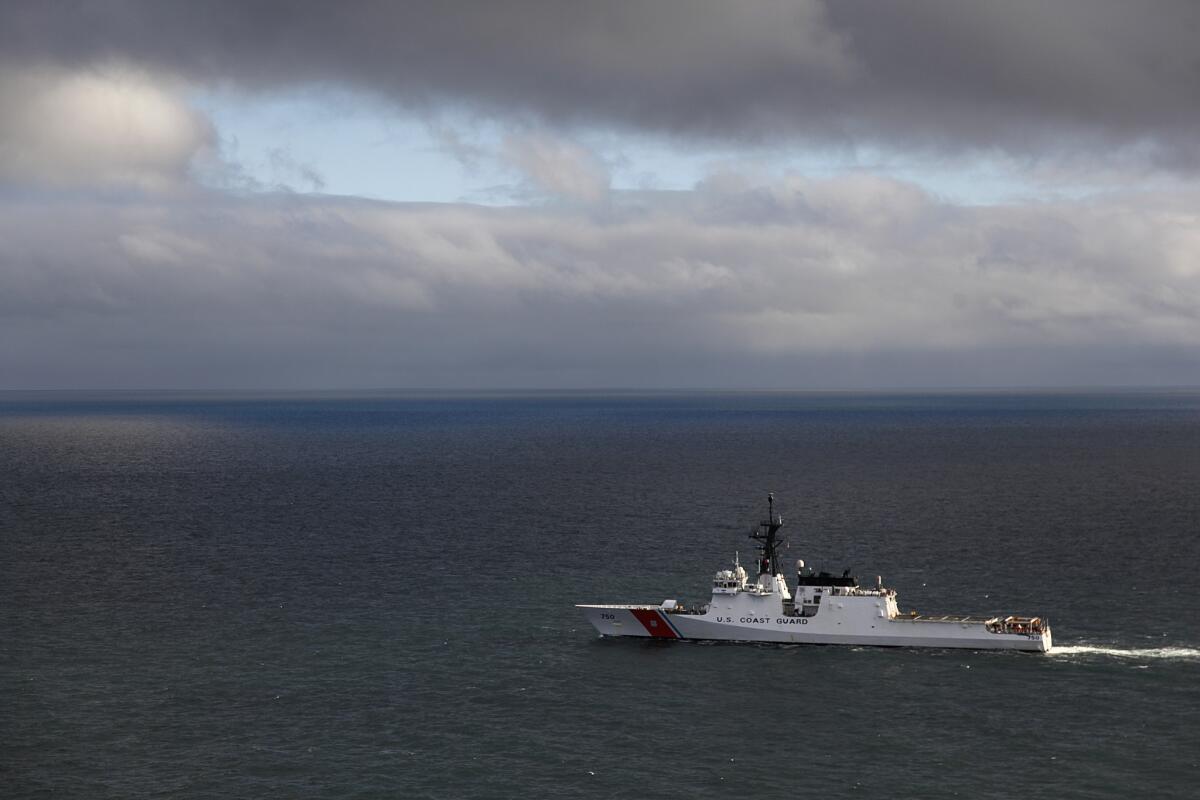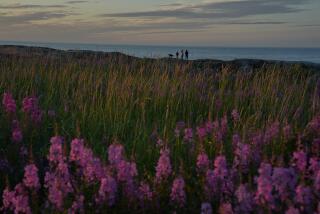As Arctic ice melts, a vast frontier opens

The Coast Guard national security cutter Bertholf patrolled the Arctic seas above Alaska in 2012.
- Share via
Reporting from Nome, Alaska — Most days in Nome, you’re not likely to run into anybody you didn’t see at the Breakers Bar on Friday night. More than 500 roadless miles from Anchorage, rugged tundra and frigid Bering Sea waters have a way of discouraging visitors.
So it was a big deal when the World, a 644-foot residential cruise ship with condos costing several million dollars apiece, dropped anchor during the summer for a two-day look-see.
“We never had a ship anywhere near this size before,” Chamber of Commerce director Mitch Erickson said. “My guess is they’ve probably been everywhere else in the world, and now they’re going to the places most people haven’t seen yet.”
That’s about to change.
The record shrinking of the polar ice cap is turning the forbidding waters at the top of the world into important new shipping routes.
Four other cruise ships also docked in Nome recently. The Coast Guard deployed its first small Arctic patrol vessels last year. Fleets of research vessels steamed north all summer, while ships surveying the vast oil and gas deposits under the Arctic seabed have talked of using Nome as a base.
In fact, this town of about 9,300 on the edge of the Bering Strait sees itself as the gateway to a newly accessible maritime frontier. Nome’s ship traffic is eight times what it was in 1990, and the town recently spent close to $90 million renovating its port to accommodate bigger ships.
To the north, Kotzebue would like to build its own deep-water port a few miles outside town. And Barrow, a remote Eskimo whaling village that sits at the very top of the continent, for the last few summers has had cruise ships full of German tourists and Coast Guard patrol boats docking near its rudimentary landing facility.
“We can no longer assume,” Alaska Gov. Sean Parnell said at a congressional hearing, “that the Arctic is an impenetrable barrier.”
The coming shipping boom has intensified concerns about how to regulate maritime operations and protect one of the most fragile and least-understood environments on Earth.
Binding international rules on what kind of vessels can operate in the Arctic do not exist. Nor do uniform regulations for routine waste discharges from ships, or reliable protocols for cleaning up spills under extreme ice conditions.
Detailed terrain maps that meet international standards exist for only about 9% of the Arctic floor, and there are no reliable high-frequency communications systems.
The Coast Guard has just two operable icebreakers in its fleet, and its closest refueling station is 1,000 miles to the southeast in Kodiak, Alaska. That’s eight hours away by rescue helicopter should a cruise ship founder on an iceberg.
“There’s water where there didn’t used to be, and we’re responsible for it,” Adm. Thad Allen, Coast Guard commandant, said in Nome this summer. “The real question is, what kind of presence and capability do we want to have up there?”
More than 6,000 ships ply the Arctic waters, according to one of the first comprehensive studies of shipping in the region, completed by the international Arctic Council in April.
The fabled Northwest Passage, linking the Atlantic and Pacific across the top of Canada, saw periods of ice-free navigation in 2007 and 2008. Forecasts anticipate 120 or more largely ice-free transit days a year by the century’s end. And last year’s record-breaking ice melt for the first time opened both the Northwest Passage and the Northeast Passage, above Russia, for several weeks.
Two German cargo ships completed a rare transit of the Northeast Passage on Sept. 7 when they sailed under escort by Russian icebreakers into the Siberian port of Yamburg. The journey, one of the first by a Western merchant vessel, began in South Korea in July and proceeded on to Europe.
The shortcut across Russia allows ships to travel the 8,700 miles from the Korean Peninsula to Europe in 23 days, rather than the 11,000-mile, 32-day voyage through the Suez Canal. Beluga Shipping, which operated the German ships, estimated that it saved 200 tons of fuel per vessel.
The Arctic Council found that growing worldwide demand for Arctic minerals is playing an even bigger role than climate change in the opening of new shipping routes in the Far North.
Red Dog -- the largest zinc mine in the world, about 90 miles northwest of Kotzebue -- operates the only major U.S. marine cargo port in the Arctic. Some of the largest ships in the world pull up off the mine’s barren stretch of frigid coastline, bound for markets all over the world.
Operators said they have no plans to expand operations or reroute their Europe-bound vessels through the Northwest Passage as part of their current operations. (They now travel south through the Panama Canal.)
But a longer ice-free period, said John Egan, the mine’s operating manager, means ore deposits in even more remote locations, including trillions of tons of coal that have lain untapped beneath northwest Alaska, might soon be made accessible.
On Baffin Island in the Canadian Arctic, development is underway to ship 18 million tons a year of high-grade iron ore through icy waters to steel mills in Europe.
Norilsk Nickel, the biggest nickel and palladium producer in the world, operating high in the Russian Arctic, this year completed delivery of its own ice-reinforced fleet.
And the Obama administration will decide soon whether to open up large sections of the offshore Arctic in Alaska to access billions of barrels of oil and gas.
“What’s really driving marine activity in the Arctic is not climate change,” said Lawson Brigham, a former Coast Guard icebreaker commander who chaired the marine shipping assessment for the Arctic Council. “It’s global economics.”
::
Rumbling up from Kodiak, Coast Guard C-130 aircraft twice a month patrol the Arctic -- surveying ice conditions, looking for potential security threats, monitoring the barges that in the summer deliver fuel and supplies to coastal villages, and eyeing the busy oil and gas operations creeping steadily seaward from the North Slope.
“There wasn’t as much of a need to get up there before,” Capt. William Deal, commanding officer of the Kodiak Coast Guard base, said as a C-130 prepared to fly north to Kotzebue and -- skimming 500 feet above the gray Arctic chop -- west over the Chukchi Sea. “But now we’re trying to make sure we’re ready for anything.”
A study now underway of Coast Guard resources is expected to determine whether the agency needs a full forward operating base in the Arctic.
If one is built, Nome wants it.
“Our argument . . . is that we’re already established; our port is already here -- we just need to go out a little deeper,” Mayor Denise Michels said.
But where will it lead, many here wonder, in a region whose villages have been among the most isolated on Earth?
“There is increasing talk of Arctic shipping lanes, expanded fisheries, new tourism opportunities and other competing uses,” North Slope Borough Mayor Edward Itta told senior Obama administration officials who traveled to Anchorage in August to deliberate what approach the government should take to the northern seas.
“In the midst of all these claims, we are trying to preserve our traditional use of our land,” said Itta, whose borough includes Barrow. “We are not afraid of change as Inupiat Eskimos. . . . But all of us know that change involves risk, and the risk of some of these potential activities in the Arctic are substantial.”
Traditional whalers worry that increased shipping and offshore oil and gas operations could injure or scare away the whales that have supported Arctic Slope residents for generations.
“With the increased traffic, just like anywhere else, the more sound that is put out there, especially the high pitches, that’s extremely harmful to [the whales]. So they’re naturally going to disappear or avoid you,” said Roy Mendenhall, who has hunted belugas from Kotzebue for years.
And conservationists fear that widespread shipping in the Arctic could triple the region’s ozone pollution and accelerate the melting of the ice, which supports the walrus, seals and polar bears on which Alaska Natives depend.
“The trade between Asia and Europe -- that’s what’s driving it,” said Tom Okleasik, planning director for the Northern Arctic Borough in Kotzebue. “It’s about cutting multiple days off the shipping time. It’s about what cuts costs for multinational corporations. It’s not about what’s best for the Arctic communities.”
::
The warming seas, however, probably would result in one economic benefit of particular interest to communities across Alaska’s Arctic Coast: Fuel must be hauled in by barge, and the limited shipping window often locks towns into accepting deliveries when gas and heating oil are at cripplingly high prices. A longer ice-free season means more purchasing flexibility.
The majority of shipping here involves regional traffic rather than vessels crossing the polar region. And analysts say that’s not likely to change soon, because even with the increased ice melt, the Northwest Passage is notoriously unpredictable. Ten ships navigated the entire length last year, and nine made it through in 2007. But this year the passage remained clogged with ice for much of the summer.
The problem, said Trudy Wohlleben, a forecaster with the Canadian Ice Service, is that heavy melting in the waterway allowed large chunks of ice from the Arctic Ocean to flow in from the north, making for treacherous waters.
That’s anathema to shipping, which depends on firm schedules and delivery dates planned months in advance.
“If you’ve got a 40% savings in distance but you can’t reliably capture that savings, then regular Arctic shipping isn’t going to happen,” said Mead Treadwell, chairman of the U.S. Arctic Research Commission.
Whether or not the route through Russia or Canada opens up, Nome expects its port to be booming with oil and gas exploration vessels, delivery barges, tourist ships and, once the region is opened for fishing, fleets of trawlers bound for Arctic waters.
“My wife and I keep pinching ourselves in amazement,” David Clyde, a tourist from Brisbane, Australia, said recently as he prepared to board a plane in Nome after an Arctic cruise. “We kept saying, ‘Are we really here watching polar bears?’ ”
“I think we’re going to see a far larger impact than we’re even conceiving,” said Leo Rasmussen, Nome’s former mayor. “People are going to be coming past Alaska. And if we are there to offer the services to those ships that want to go either way, if we’re there to protect the ships while they’re in our sphere of influence, if we offer better services than our neighbor next door in Russia -- then we become the entrance and exit to the entire Arctic Ocean.”
Twitter: @kimmurphy
More to Read
Sign up for Essential California
The most important California stories and recommendations in your inbox every morning.
You may occasionally receive promotional content from the Los Angeles Times.










